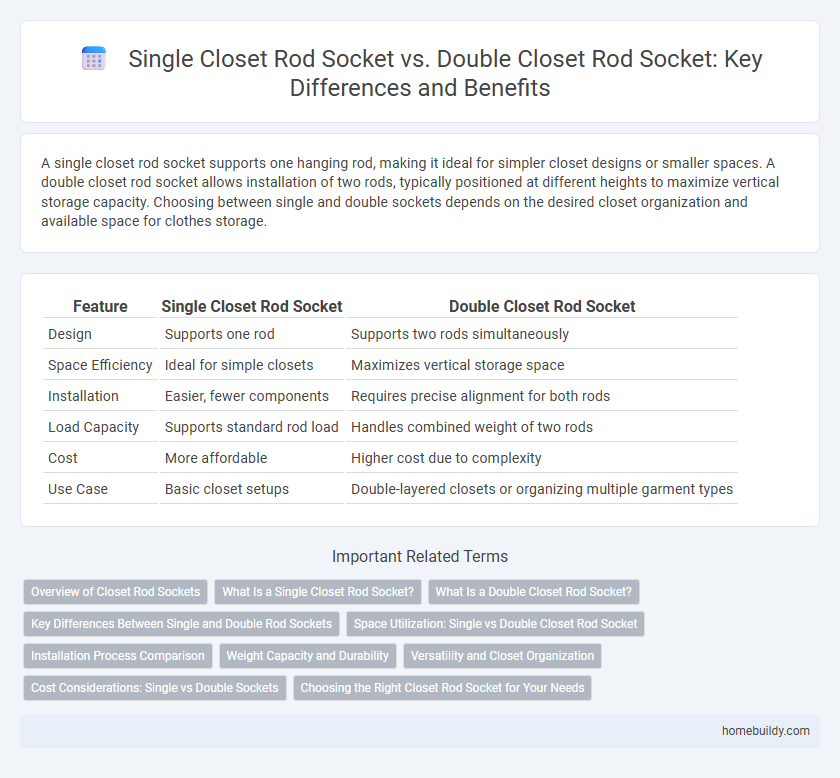A single closet rod socket supports one hanging rod, making it ideal for simpler closet designs or smaller spaces. A double closet rod socket allows installation of two rods, typically positioned at different heights to maximize vertical storage capacity. Choosing between single and double sockets depends on the desired closet organization and available space for clothes storage.
Table of Comparison
| Feature | Single Closet Rod Socket | Double Closet Rod Socket |
|---|---|---|
| Design | Supports one rod | Supports two rods simultaneously |
| Space Efficiency | Ideal for simple closets | Maximizes vertical storage space |
| Installation | Easier, fewer components | Requires precise alignment for both rods |
| Load Capacity | Supports standard rod load | Handles combined weight of two rods |
| Cost | More affordable | Higher cost due to complexity |
| Use Case | Basic closet setups | Double-layered closets or organizing multiple garment types |
Overview of Closet Rod Sockets
Single closet rod sockets securely hold one rod, providing a straightforward solution for basic storage needs, ideal for lighter loads and minimal closet space. Double closet rod sockets accommodate two rods on top of each other, maximizing vertical space and enhancing organizational capacity in larger closets. Both types are typically made from durable materials like metal or sturdy plastic, designed to support different weight capacities based on rod size and closet configuration.
What Is a Single Closet Rod Socket?
A single closet rod socket is a hardware fitting designed to hold one closet rod securely in place, providing sturdy support for hanging clothes. It is typically used in wardrobes or closets where only one hanging rod is needed. This type of socket is essential for maximizing space efficiency while maintaining stable rod installation.
What Is a Double Closet Rod Socket?
A double closet rod socket is a hardware fitting designed to hold two parallel closet rods, maximizing vertical storage space within a wardrobe. Unlike a single closet rod socket that secures one rod, the double socket provides two mounting points, allowing for efficient organization of hanging clothes on separate levels. This configuration is ideal for optimizing closet capacity without expanding the physical dimensions of the storage area.
Key Differences Between Single and Double Rod Sockets
Single closet rod sockets support one hanging rod, making them ideal for simpler wardrobe setups or smaller closets with limited storage needs. Double closet rod sockets accommodate two rods simultaneously, doubling hanging space and enhancing organization in larger closets or walk-ins. The key differences lie in their load capacity, installation complexity, and space utilization, with double sockets offering sturdier support and more efficient use of vertical space.
Space Utilization: Single vs Double Closet Rod Socket
Single closet rod sockets provide a straightforward solution for hanging clothes in limited spaces, utilizing one rod that maximizes vertical storage without overcrowding. Double closet rod sockets double the hanging capacity by allowing two rods to be installed, effectively increasing horizontal space utilization and accommodating more garments in the same closet footprint. Choosing between single and double closet rod sockets depends on wardrobe size and available closet dimensions, balancing ease of access with optimal space efficiency.
Installation Process Comparison
Single closet rod sockets offer a straightforward installation process, typically requiring just two screws per socket and minimal alignment adjustments, making them ideal for simple wardrobe setups. Double closet rod sockets demand more precise measurements and secure mounting to support the weight of two rods, often needing additional hardware and careful leveling to ensure stability and balanced load distribution. Choosing between single and double sockets hinges on workspace requirements and the installer's experience, with double sockets generally requiring more time and meticulous installation techniques.
Weight Capacity and Durability
Single closet rod sockets typically support weight capacities up to 50 pounds, suitable for lighter loads and general use. Double closet rod sockets are engineered for enhanced durability and can hold significantly more weight, often exceeding 100 pounds, making them ideal for heavy-duty storage. The robust construction and reinforced design of double sockets provide greater stability and longevity compared to single sockets.
Versatility and Closet Organization
Single closet rod sockets offer streamlined support for one rod, ideal for minimalist closet designs and maximizing vertical space. Double closet rod sockets enhance versatility by allowing installation of two rods within the same vertical area, effectively doubling hanging capacity and promoting organized separation of clothing types. Incorporating double sockets aids in optimizing closet organization, providing tailored storage solutions for varied garment lengths and boosting overall space efficiency.
Cost Considerations: Single vs Double Sockets
Single closet rod sockets generally cost less due to simpler design and fewer materials, making them ideal for budget-conscious projects. Double closet rod sockets, while more expensive, offer greater functionality by supporting two rods in the same space, reducing the need for additional hardware. Choosing between single and double sockets involves balancing upfront costs against long-term storage efficiency and installation needs.
Choosing the Right Closet Rod Socket for Your Needs
Single closet rod sockets provide strong, reliable support for one rod, ideal for standard closet layouts with limited hanging space. Double closet rod sockets accommodate two rods, maximizing vertical storage and enabling efficient use of closet height for clothing organization. Selecting the right closet rod socket depends on your closet size, storage requirements, and the weight capacity needed to ensure durability and optimal functionality.
Single closet rod socket vs Double closet rod socket Infographic

 homebuildy.com
homebuildy.com